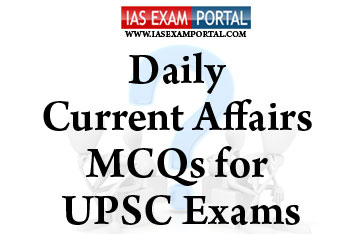Current Affairs MCQ for UPSC Exams - 15 MAY 2019
Q1. India has been unanimously chosen as co-chair of the
Consultative Group (CG) of Global Facility for Disaster Reduction and Recovery (GFDRR)
for the fiscal year 2020.
Which of the following regarding the same are true ?
1) GFDRR is a global partnership that helps developing countries
better understand and reduce their vulnerability to natural hazards and climate
change.
2) It is a grant-funding mechanism, managed by the WTO, that supports disaster
risk management projects worldwide.
3) This will give the country an opportunity for India to work with the member
countries and organizations with a focused contribution towards advancing the
disaster risk reduction agenda during the course of the year.
a) 1 & 2 only
b) 2 & 3 only
c) 1 & 3 only
d) all of the above
Q2. Consider the following pairs of vitamins/minerals and their
deficiency disorders :
1) Iodine : Goitre
2) Vitamin C : Bone and tooth decay
3) Vitamin D : Rickets
4) Calcium : Scurvy
5) Iron : Anaemia
Which of the above pairs are correctly matched ?
a) 1,2 & 3 only
b) 3,4 & 5 only
c) 1,3 & 5 only
d) 2 & 4 only
Q3. Which of the following statements regarding the recently
published World Insurance Report 2019 are true ?
1) As per the report, 83% of personal insurance customers have
medium or high exposure to cyberattacks and to outliving their savings, yet just
3% and 5% respectively are comprehensively covered against these eventualities.
2) Under 25% of business customers across all geographies, and less than 15% of
personal policyholders, feel they have sufficient coverage to insure against any
one of the emerging risks driven by these macro trends.
3) A per the report, risk assessment capabilities can be significantly enhanced
through deployment of machine learning, artificial intelligence and advanced
analytics, and effective collaboration with tech providers.
a) 1 & 2 only
b) 2 & 3 only
c) 1 & 3 only
d) all of the above
Q4. Consider the following statements with respect to climate
change and its mitigation techniques :
1) Climate change, plus relentless industrial farming and
fishing are leading to the extinction of 1 million species from Mother Earth
within decades.
2) We need to replace carbon-based fuels, with other forms of energy generation
that do not generate greenhouse gases; hence solar power, wind power and others.
Also enhance all natural methods which absorb CO2.
3) Tropical forests house over 200 million species of plants, animals and fungi.
They are thus termed as Key Biodiversity Areas (KBAs). They restore and protect
biodiversity, increase yields and enhance ecosystem protection and defense,
hence deforestation should be avoided in these regions.
Which of the above statements are true ?
a) 1 & 2 only
b) 2 & 3 only
c) 1 & 3 only
d) all of the above
Q5. The global services trade restrictive index ( STRI )is
released by which of the following global organisations ?
a) World Bank
b) WTO
c) OECD
d) IMF


